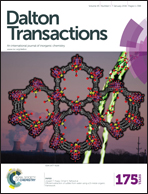Manganese coordination chemistry of bis(imino)phenoxide derived [2 + 2] Schiff-base macrocyclic ligands†
Abstract
The [2 + 2] Schiff-base macrocycles [2,2′-(CH2CH2)(C6H4N![[double bond, length as m-dash]](https://www.rsc.org/images/entities/char_e001.gif) CH)2-2,6-(4-RC6H2OH)]2 (IRH2), upon reaction with MnCl2 (two equivalents) afforded the bimetallic complex [Cl3Mn(μ-Cl)Mn(IMeH2)] (1) or the salt complex [Cl3Mn(NCMe)][MnCl(ItBuH2)] (2). Under similar conditions, use of the related [2 + 2] oxy-bridged macrocycle [2,2′-O(C6H4N
CH)2-2,6-(4-RC6H2OH)]2 (IRH2), upon reaction with MnCl2 (two equivalents) afforded the bimetallic complex [Cl3Mn(μ-Cl)Mn(IMeH2)] (1) or the salt complex [Cl3Mn(NCMe)][MnCl(ItBuH2)] (2). Under similar conditions, use of the related [2 + 2] oxy-bridged macrocycle [2,2′-O(C6H4N![[double bond, length as m-dash]](https://www.rsc.org/images/entities/char_e001.gif) CH)2-4-RC6H2OH] (IIRH2), afforded the bimetallic complexes [(MnCl)2IIR] (R = Me 3, tBu 4), whilst the macrocycle derived from 1,2-diaminobenzene and 5,5′-di-tert-butyl-2,2′-dihydroxy-3,3′-methylenedibenzaldehyde (IIIH4) afforded the complex [(MnCl)2(III)]·2MeCN (5·2MeCN). For comparative studies, the salt complexes [2,6-(ArNHCH)2-4-MeC6H2O][MnCl3(NCMe)] (Ar = 2,4-Me2C6H3, 6) and {[(2-ArN
CH)2-4-RC6H2OH] (IIRH2), afforded the bimetallic complexes [(MnCl)2IIR] (R = Me 3, tBu 4), whilst the macrocycle derived from 1,2-diaminobenzene and 5,5′-di-tert-butyl-2,2′-dihydroxy-3,3′-methylenedibenzaldehyde (IIIH4) afforded the complex [(MnCl)2(III)]·2MeCN (5·2MeCN). For comparative studies, the salt complexes [2,6-(ArNHCH)2-4-MeC6H2O][MnCl3(NCMe)] (Ar = 2,4-Me2C6H3, 6) and {[(2-ArN![[double bond, length as m-dash]](https://www.rsc.org/images/entities/char_e001.gif) CH),6-(ArNHCH)-4-Me-C6H2O]MnCl}2[MnCl4]·8CH2Cl2 (Ar = 4-MeC6H4, 7·8CH2Cl2) were prepared. The crystal structures of 1–7 are reported (synchrotron radiation was necessary for complexes 1, 3 and 5). Complexes 1–7 (not 5) were screened for their potential to act as pre-catalysts for the ring opening polymerization (ROP) of ε-caprolactone; 3, 4 and 6, 7 were inactive, whilst 1 and 2 exhibited only poor activity with low conversion (<15%) at temperatures above 60 °C.
CH),6-(ArNHCH)-4-Me-C6H2O]MnCl}2[MnCl4]·8CH2Cl2 (Ar = 4-MeC6H4, 7·8CH2Cl2) were prepared. The crystal structures of 1–7 are reported (synchrotron radiation was necessary for complexes 1, 3 and 5). Complexes 1–7 (not 5) were screened for their potential to act as pre-catalysts for the ring opening polymerization (ROP) of ε-caprolactone; 3, 4 and 6, 7 were inactive, whilst 1 and 2 exhibited only poor activity with low conversion (<15%) at temperatures above 60 °C.
![Graphical abstract: Manganese coordination chemistry of bis(imino)phenoxide derived [2 + 2] Schiff-base macrocyclic ligands](/en/Image/Get?imageInfo.ImageType=GA&imageInfo.ImageIdentifier.ManuscriptID=C5DT03453A&imageInfo.ImageIdentifier.Year=2016)

 Please wait while we load your content...
Please wait while we load your content...